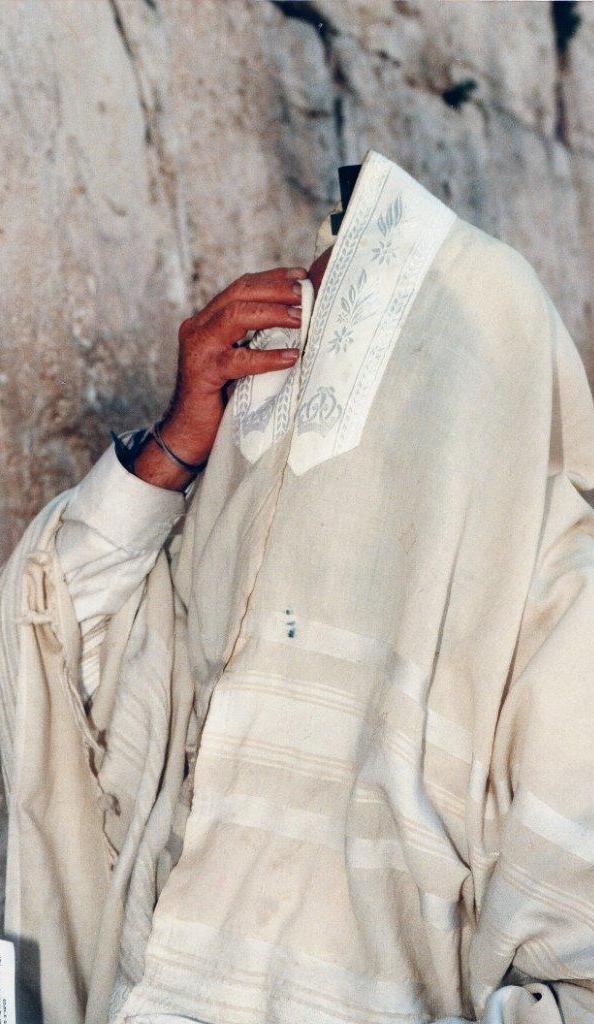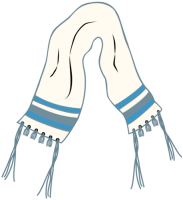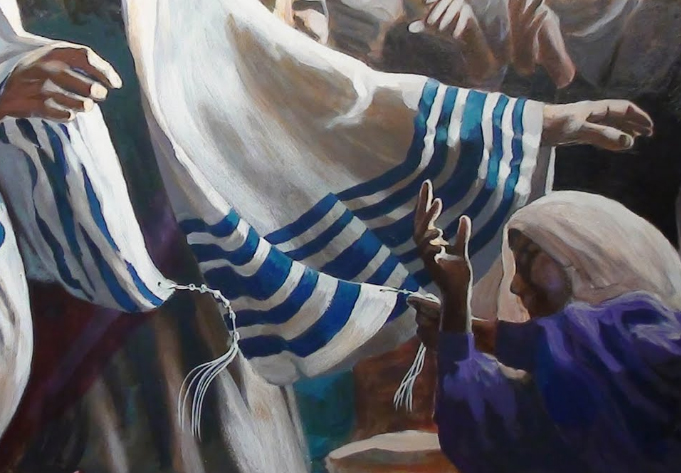What Is A Prayer Closet?
Matthew 6:5-8 (KJV)
And when thou prayest,
thou shalt not be as the hypocrites are:
for they love to pray standing
in the synagogues and in the corners of the streets,
that they may be seen of men.
Verily I say unto you, They have their reward.
But thou, when thou prayest,
enter into thy closet,
and when thou hast shut thy door,
pray to thy Father which is in secret;
and thy Father which seeth in secret
shall reward thee openly.
But when ye pray, use not vain repetitions,
as the heathen do:
for they think that they shall be heard for their much speaking.
Be not ye therefore like unto them:
for your Father knoweth what things ye have need of,
before ye ask him.
The Greek word for “closet” is “temian” which means
an inner chamber or a secret room.
However, in the Hebraic minds, the prayer closet is something
else. It is the prayer shawl or
tallit. This is not a closet or a room in a house. Not a physical
place but a posture of the human heart towards God.
Tallit (or talith) contains two Hebrew words. “Tal” meaning
"tent" and “ith” meaning "little." Thus, tallit means “little tent.”
The plural of tallit is tallitot. Most Jewish men own tallitot.
Each man can have his own little tent for prayer. This is a time of
intimacy with God, totally set apart from anyone else.
Even in public places like Western Wall filled with
 crowds of people praying all kinds of prayers, a tallit becomes a
secret place where one can meet God face to face. Not praying
publicly where everyone can see but closing the doors of these
little tents, one can commune with God as friend with friend. This
tallit is a very private and personal prayer closet.
crowds of people praying all kinds of prayers, a tallit becomes a
secret place where one can meet God face to face. Not praying
publicly where everyone can see but closing the doors of these
little tents, one can commune with God as friend with friend. This
tallit is a very private and personal prayer closet.
Prayer is our communication with God! It is best manifested when we
can focus fully on God, totally separated from any other
interferences or worldly distractions. Inside the tallit, we can
find a secret chamber where we can be moved from the mundane of life
into a closer relationship with God! A holy place of prayer!
John Wesley’s mother was a great woman of prayer. In the midst of
taking care of her 19 children, she would sit on a chair and throw
her apron over her head. This was a sign for her kids to leave her
alone. This was her sweet hour of prayer. No matter how busy she
was, she needed a quiet time away from the daily chores and
routines.
The tallit is more than a prayer closet. Let’s take a closer look at
it.
Numbers 15:37-41
Again the LORD spoke to Moses, saying,
“Speak to the children of Israel:
Tell them to make tassels on the corners of their
garments
throughout their generations,
and to put a blue thread in the tassels of the
corners.
And you shall have the tassel,
that you may look upon it and
remember all the commandments of the LORD
and do them,
and that you may not follow the harlotry
to which your own heart and your own eyes are inclined,
and that you may remember and do all My commandments,
and be holy for your God.
I am the LORD your God,
who brought you out of the land of Egypt,
to be your God: I am the LORD your God.”
These tassels remind the Israelites of their responsibilities to
fulfill all of God’s commandments, and their calling to be a holy
people unto the LORD.
As they look upon the tassels, they remember all the commandments of
the LORD, and do them! Why is this so? How is the tallit able to
accomplish such awesome tasks?
The tallit has special twined and knotted fringes or
tassels known as tzitzit attached to its four corners.
 The numerical value of the word tzitzit is 600. Each of the
fringes contains 8 threads and 5 knots, making a total of 613. This
divine number corresponds to all the 613 commandments in the Torah.
The numerical value of the word tzitzit is 600. Each of the
fringes contains 8 threads and 5 knots, making a total of 613. This
divine number corresponds to all the 613 commandments in the Torah.
Tying the tzitzit is a skilful art of precise winding and knotting.
When done correctly, the Tzitzit will have 7-8-11-13 windings
between the five knots.
What does this 7-8-11-13 pattern mean?
7+8=15. In Hebrew, 15 is written yod-hay (YH), the first
two letters of God's name (YHWH, the Tetragrammaton). 11=vav-hay
(WH), which are the last two letters of God's name.
Thus the first three sets of windings reveal God's holy name.
13, the last set of windings, is equivalent in value to the word
"echad" which means "one."
Hence, all four sets of windings together declare, "God is one." This is the
Shema, a proclamation of our faith and belief in one God.
Deuteronomy 6:4
Hear, O Israel: The LORD our God, the LORD is one!
It is customary for the Israelites wearing tallitot to hold the four
fringes in the left hand while reciting the Shema, and to kiss the
fringes as a sign of love and affection for the holy commandments.
7+8+11+13=39. This number reminds us that Jesus suffered 39 stripes
for our sins and healing!
 Isaiah 53:5
Isaiah 53:5
But He was wounded for our transgressions,
He was bruised for our iniquities;
The chastisement for our peace was upon Him,
And by His stripes we are healed.
Remember the woman who suffered from a flow of blood for 12 years.
When she heard of Jesus, she came to see Him and she knew where to
touch Him. She came from behind, and touched the hem of His garment.
What were on the hem of His garments? The tassels. By touching the
tassels of His tallit in faith, the anointing of God flowed unto her
and she was made whole!
Matthew 9:20-21
And suddenly, a woman who had a flow of blood for twelve years
came from behind and touched the hem of
His garment.
For she said to herself, “If only I may touch His garment, I shall
be made well.”
Each Tzitzit is made from 8 strings, 7 white and 1 blue. 7
represents perfection in the physical realm. Therefore, 8 transcends 7 by linking the physical realm directly to the spiritual
realm. Thus man is able to commune with God.
Each group of 8 strings is knotted 5 times to form a tzitzit. There
are five books in the Torah.
There are 4 tzitzit. Each of the 4 tzitzit has 8 strings, making a
total of 32 strings. 32 in Hebrew means “heart.” The 32
strings represent a heart for God!
Tassels are sewn on the corners of the mantle or outer garment (a
rectangular piece of cloth) with a thread of blue. The threads of
the tassels are white to symbolize righteousness. The blue thread is
placed among the white threads to symbolize the heavenly origin of
the commandments.
Interesting, the Hebrew word for “law” is “hallaga” which means
“walk.” Walking while wearing a tallit simply means walking with God
and obeying all His laws. Like Jesus our Lord and Saviour did.
Matthew 5:17-20
Do not think that I came to destroy the Law or the Prophets.
I did not come to destroy but to fulfill.
For assuredly, I say to you, till heaven and earth pass away,
one jot or one tittle will by no means pass from the law
till all is fulfilled.
Whoever therefore breaks one of the least of these commandments,
and teaches men so, shall be called least in the kingdom of heaven;
but whoever does and teaches them,
he shall be called great in the kingdom of heaven.
For I say to you, that unless your righteousness
exceeds the righteousness of the scribes and Pharisees,
you will by no means enter the kingdom of heaven.
Most tallitot are beautifully woven from wool and have a neckband,
called an atarah (crown), that has a blessing or design embroidered
on it.
Barukh atah Adonai, Eloheinu, melekh ha'olam
Blessed are you, Lord, our God, Sovereign of the universe
Asher kidishanu b'mitz'votav v'tzivanu l'hit'ateif
ba-tzitzit
Who has sanctified us with His commandments and commanded us to wrap
ourselves in the tzitzit
This blessing is placed over the head, on the outside, just like the
tent walls of the Holy Tabernacle so that they will always hang out
in the same way. As the atarah is placed over the head, it forms a
personal tent. Wings of the garment are formed when the arms are
held out. In doing so, the glory of His presence fills the little tent!
Psalm 91:1-2
He who dwells in the secret place
of the Most High
Shall abide under the shadow of the
Almighty.
I will say of the LORD,
“He is my refuge and my fortress;
My God, in Him I will trust.”
Paul the apostle was a Jew. He was also a tentmaker. During Paul’s
time, most people already lived in houses and not tents. Many
believed that he made little tents or prayer shawls, and not big
nomadic tents for people to live in.
Today, the Jewish people use tallitot for prayer and celebration, in
joy and in sorrow. It is used at all major Jewish occasions:
circumcisions, bar mitzvah (boys at age 13), bat mitzvah (girls at
the age 13), weddings and burials. The tallit is used to protect the
scrolls of the Torah when they are being moved. During funerals, the
dead are wrapped in it when they are buried (but without the
tassels). During weddings, the bride and bridegroom are covered with
the canopy of the prayer shawl. The tallit also inspires the design
of the Jewish national flag!
Thus a tallit is more than a prayer closet. It reminds us about all
the commandments of God and the holy name of God! That is something
we need to learn and adapt in our life! This is the kind of prayer
life that our Lord Jesus had.
Proverbs 28:9
One who turns away his ear from hearing the law,
Even his prayer is an abomination.
Therefore, by the mercies of God, we need to present our bodies a
living sacrifice, holy, acceptable to God, which is our reasonable
service. And that we will not be conformed to this world, but be
transformed by the renewing of our minds, that we may prove what is
that good and acceptable and perfect will of God. When we do so, our
prayers will be a sweet and fragrant incense rising up to His
throne.
Sources:
http://www.godsoutreachministryint.org/PrayerShawl.htm
Written on 16 May 2013